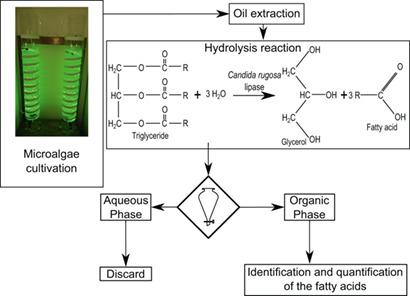当前位置:
X-MOL 学术
›
Chem. Eng. Technol.
›
论文详情
Our official English website, www.x-mol.net, welcomes your feedback! (Note: you will need to create a separate account there.)
Microalgae as a Feedstock for Sustainable Fatty Acids: Factorial Design Study
Chemical Engineering & Technology ( IF 2.1 ) Pub Date : 2019-09-30 , DOI: 10.1002/ceat.201800643 Patrícia Caroline Molgero Rós 1 , Talitha Kühn Menezes 1 , Eduardo Henrique Bredda 2 , Messias Borges Silva 1, 2 , Heizir Ferreira Castro 1
Chemical Engineering & Technology ( IF 2.1 ) Pub Date : 2019-09-30 , DOI: 10.1002/ceat.201800643 Patrícia Caroline Molgero Rós 1 , Talitha Kühn Menezes 1 , Eduardo Henrique Bredda 2 , Messias Borges Silva 1, 2 , Heizir Ferreira Castro 1
Affiliation

|
Microalgal oil from Nannochloropsis gaditana cultivated in a laboratory‐scale photobioreactor was submitted to enzymatic hydrolysis using Candida rugosa lipase. A 22 full factorial design was performed to evaluate the effects of the soy lecithin emulsifier concentration and the lipase loading on the formation of free fatty acids. As control, a similar set of reactions was carried out with macaw palm oil. The results showed similar hydrolysis yields for both feedstocks. The highest value was reached when the concentrations of soy lecithin and lipase were taken at their lowest and highest levels, respectively. The hydrolysate from microalgal oil showed that the majority of the fatty acids released by C. rugosa consisted of palmitic, oleic, and linoleic acids.
中文翻译:

微藻作为可持续脂肪酸的原料:析因设计研究
在实验室规模的光生物反应器中培养的Nannochloropsis gaditana的微藻油已使用皱纹假丝酵母脂肪酶进行了酶促水解。进行2 2全因子设计以评估大豆卵磷脂乳化剂浓度和脂肪酶负载量对游离脂肪酸形成的影响。作为对照,用金刚鹦鹉棕榈油进行了类似的反应。结果表明两种原料的水解产率相似。当大豆卵磷脂和脂肪酶的浓度分别处于最低和最高水平时,则达到最高值。微藻油中的水解产物表明皱纹念珠菌释放的大部分脂肪酸 由棕榈酸,油酸和亚油酸组成。
更新日期:2019-09-30
中文翻译:

微藻作为可持续脂肪酸的原料:析因设计研究
在实验室规模的光生物反应器中培养的Nannochloropsis gaditana的微藻油已使用皱纹假丝酵母脂肪酶进行了酶促水解。进行2 2全因子设计以评估大豆卵磷脂乳化剂浓度和脂肪酶负载量对游离脂肪酸形成的影响。作为对照,用金刚鹦鹉棕榈油进行了类似的反应。结果表明两种原料的水解产率相似。当大豆卵磷脂和脂肪酶的浓度分别处于最低和最高水平时,则达到最高值。微藻油中的水解产物表明皱纹念珠菌释放的大部分脂肪酸 由棕榈酸,油酸和亚油酸组成。



























 京公网安备 11010802027423号
京公网安备 11010802027423号